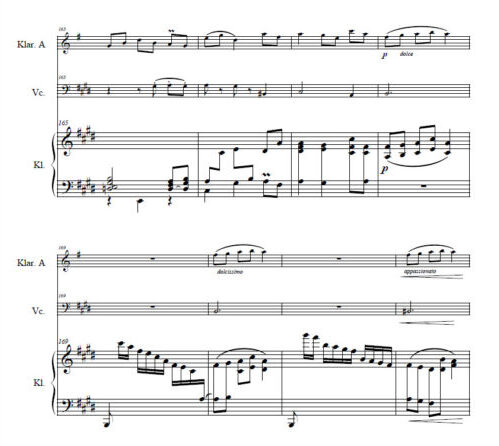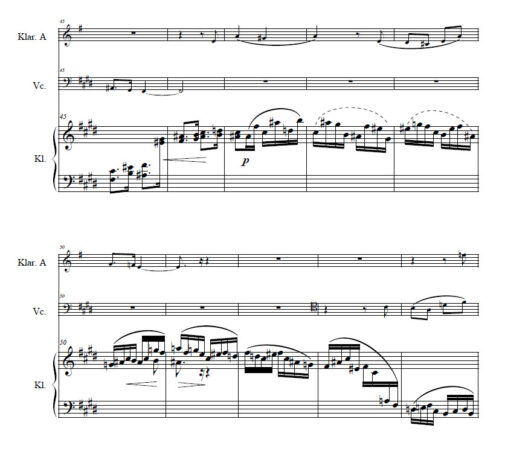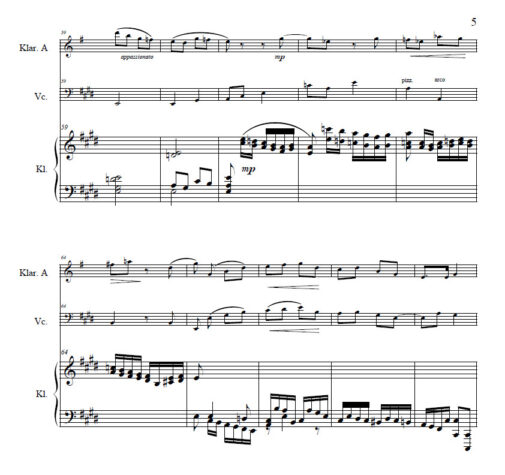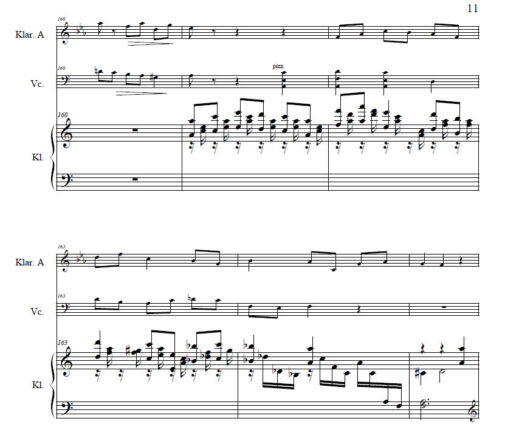Thoughts on the Piano Part in Josef Labor’s Trio and Cello Sonata
von Holger Busch
Page 1 of the score of the “Trio for Piano, Clarinet and Cello”, which Gerhard Waiz, the cellist of the ensemble TRIS, has lovingly and time-consumingly brought into legible form as a copy of the manuscript, has the following special feature: “Begun with God on 15 August 1917”. This arouses my interest and I turn to the last page, and after two quarter pauses and a double bar, I actually read “15 November 1917”, and in this way all the other sentences are also precisely dated, which would be righteously consistent.
There is no dedication under the title; on first inspection, the whole thing looks rather transparent than overloaded; only on the cover page of the “Cello Sonata in C Major” is the addition: “for Mr. Paul Wittgenstein” and, naturally, at the top left: “Begun with God on 18 August 1918”. Finally, the person to whom the work was assigned is mentioned by name, as was perhaps made socially acceptable with Beethoven, but in these cases both works are actually written to “fit” the pianist Paul Wittgenstein.
The piano part is traditionally notated in two systems, treble and bass clef, and seems balanced over long stretches. If one knew nothing more about the real circumstances, the pianist would consequently begin to study, play, learn, refine, but pause: Paul Wittgenstein lost his right arm in 1915 during the First World War! Interestingly, there is no mention of this fact, no “For the left hand alone” in all its linguistic variations. Others did not shy away from prescribing clear handling and gave the pianists of this world full-fledged to ingenious works precisely for the left hand alone, more rarely also for the right hand; not a word about this from Labor. Perhaps they didn’t want to make a fuss about this special feature and wanted Wittgenstein to continue to be recognised as a “normal” pianist and not because of a handicap?
This compelling, because pragmatic, fact saves both works from the suspicion of being “show pieces” that owe their effect to the acrobatic gestures of the pianist. Nevertheless, when performed with the left hand alone, a number of challenges arise, some of which I would like to point out using the example of the trio.
- No pedal indications at all, so the performer must decide how long a harmony should continue to sound despite additional notes that are not part of the chord.
- Changes of register between bass and treble, wide chord leaps, as here in the 4th movement:

- Playing in the highest position (unfavourable sitting position).
- Excessive sixteenth-note passages, which are set monophonically but intended polyphonically (2nd movement).

- Passages in thirds, sixths and octaves (4th movement, II. &. IV. Variation):

- up to 6-part arpeggios (3rd movement).
- rapid arpeggios in the highest register (2nd movement, Tempo di Menuetto):

- large-scale fugato with 2 independent voices without a further supporting voice (4th movement, IV. variation).
In fact, I had originally rehearsed the trio left-handed and played it repeatedly in concerts with TRIS. The CD recording that we made in the summer of 2020 was a different challenge; recording studio instead of concert hall meant above all: hours of recording with repetitions until everything fit. Could I do this reliably without touching the little finger of the right hand, which is used to eliciting a silvery or radiant upper voice from the instrument in chord playing? So now the thumb of the left hand was always supposed to step in and take over a task for which it had not been trained for decades? A great burden was placed on me, which had to be mastered responsibly.
The decision was made after careful consideration, questioning again and again: I took courage and learned the trio “anew” with the help of my right hand! Not all the time and everywhere, not out of convenience, merely in great responsibility towards the artistic quality of the work.
I pay homage to the great pianist Paul Wittgenstein, who had only his left hand at his disposal. I accept the task and use the means at my disposal: two hands. Otherwise, the work would remain forgotten, the manuscript slumbering unnoticed in the estate of Josef Labor.